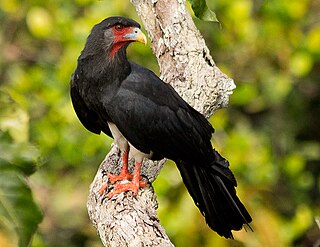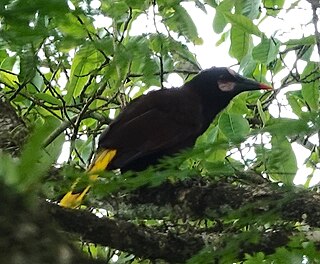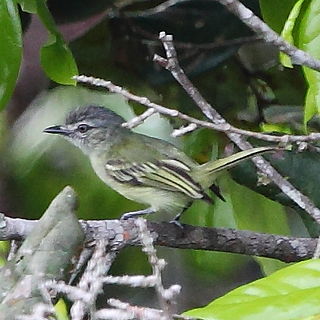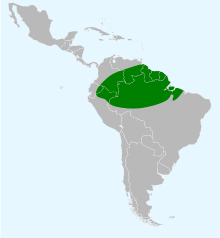
Linnaeus's mouse opossum, also known as the common or murine mouse opossum, is a South American marsupial of the family Didelphidae.

The crested oropendola, also known as the Suriname crested oropendola or the cornbird, is a New World tropical icterid bird. It is a resident breeder in lowland South America east of the Andes, from Panama and Colombia south to northern Argentina, as well as on Trinidad and Tobago. If the genus Gymnostinax for the Montezuma oropendola and its closest relatives were considered valid, this species would probably belong in that genus.

The giant cowbird is a large passerine bird in the New World family Icteridae. It breeds from southern Mexico south to northern Argentina, and on Trinidad and Tobago. It may have relatively recently colonised the latter island. It is a brood parasite and lays its eggs in the nests of other birds.

The shiny cowbird is a passerine bird in the New World family Icteridae. It breeds in most of South America except for dense forests and areas of high altitude such as mountains. Since 1900 the shiny cowbird's range has shifted northward, and it was recorded in the Caribbean islands as well as the United States, where it is found breeding in southern Florida. It is a bird associated with open habitats, including disturbed land from agriculture and deforestation.

Oropendolas are a genus of passerine birds, Psarocolius, in the New World blackbird family Icteridae. They were formerly split among two or three different genera and are found in Central and South America.

The bronzed cowbird, once known as the red-eyed cowbird, is a small icterid.

The chestnut-headed oropendola is a New World tropical icterid bird. The scientific name of the species commemorates Johann Georg Wagler, who established Psarocolius, the oropendola genus.

The Montezuma oropendola is a New World tropical icterid bird. It is a resident breeder in the Caribbean coastal lowlands from southeastern Mexico to central Panama, but is absent from El Salvador and southern Guatemala. It also occurs on the Pacific slope of Nicaragua and Honduras and northwestern and southwestern Costa Rica. It is among the oropendola species sometimes separated in the genus Gymnostinops. The English and scientific names of this species commemorate the Aztec emperor Moctezuma II.

The subtropical cacique is a passerine bird species in the New World family Icteridae. It breeds in the lower reaches of the northern Andes.

The olive oropendola is the largest member of the icterid family and rivals the Amazonian umbrellabird as the largest passerine bird in South America. It is sometimes placed in the genus Gymnostinops instead of Psarocolius. As suggested by its name, it is found widely – but often in low densities – throughout humid lowland forests of the Amazon Basin, with the notable exception of most of the Guiana Shield. It is sometimes split into two species, the western olive oropendola and the eastern Pará oropendola, but the subspecies P. y. neivae is widely recognized as a hybrid swarm, and the vast majority of authorities consider them a single species.

The black caracara is a species of bird of prey in the family Falconidae found in Amazonian and French Guianan lowlands, occurring commonly along rivers. They are locally referred to as Ger' futu busikaka in the Republic of Suriname, and juápipi {nẽjõmbʌ} by the Emberá of Panamá and Colombia. However, both of these names refer to multiple bird species within the Falconidae. German-Brazilian ornithologist Helmut Sick also referred to this species as gavião-de-anta, literally translating to "tapir-hawk".

The red-throated caracara is a social species of bird of prey in the family Falconidae. It is placed in the monotypic genus Ibycter, or sometimes united in Daptrius with the black caracara. Unique among caracaras, it mainly feeds on the larvae of bees and wasps, but also takes the adult insects and fruits and berries.

The sapphire-rumped parrotlet is a species of bird in subfamily Arinae of the family Psittacidae, the African and New World parrots. It is found in Brazil, Colombia, Ecuador, French Guiana, Guyana, Peru, Suriname, and Venezuela.

The violaceous jay is a species of bird in the family Corvidae, the crows and their allies.

The red-bellied grackle is a species of bird in the family Icteridae. Its genus, Hypopyrrhus, is monotypic.

Bates's sunbird is a species of sunbird in the family Nectariniidae which occurs in Western African forests and Central African rainforests, and locally in other types of forest in Central Africa.

The dusky-green oropendola is a species of bird in the family Icteridae. It is found on the eastern slope of the Andes in Bolivia and Peru. Its natural habitats are subtropical or tropical moist montane forests and heavily degraded former forest.

The Baudó oropendola is a species of bird in the family Icteridae. It is endemic to Colombia. Its natural habitat is subtropical or tropical moist lowland forests, which are threatened by destruction. As it is only known from a small number of locations, its conservation status has been assessed as "endangered" by the IUCN.

The black oropendola is a species of bird in the family Icteridae. It is found in Colombia and Panama. Its natural habitat is subtropical or tropical moist lowland forests.

The grey-crowned flatbill or grey-crowned flycatcher is a species of bird in the family Tyrannidae. It is found in humid forest in the Amazon and Atlantic Forest in South America. It closely resembles the yellow-margined and yellow-olive flatbills, but its lower mandible is dark with a pale base. It is a fairly common bird with a wide range and the International Union for Conservation of Nature has rated it as "least concern".























